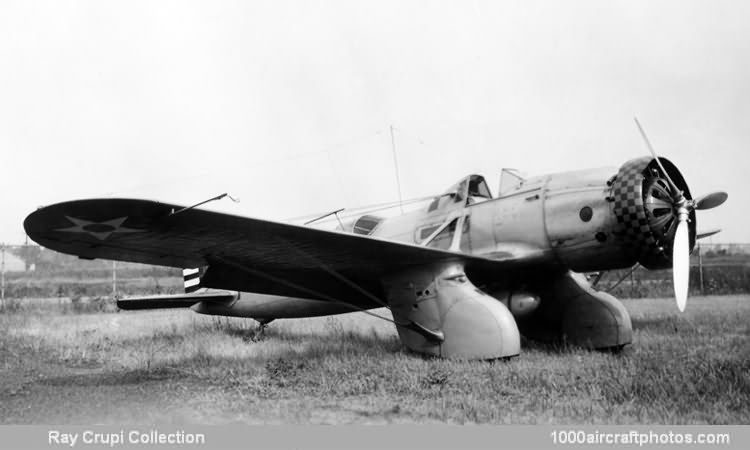02/28/2011. Remarks by Johan Visschedijk: "The XA-8 was designed to an Army request for an all-metal low-wing attack monoplane and, serialed 30-387, first flew in 1931. Its direct competitor was the General Aviation XA-7. Fuselage was the then-new smooth skin semi-monocoque construction while the conventional two-spar wings were covered with aluminum sheet and braced with wires and introduced an innovation to Army aircraft-trailing edge flaps.
Forward firing armament was four 0.30 in (7.62 mm) machine guns in the landing gear fairings while the rear gunner had a single flexible 0.30 in (7.62 mm). Four 100 lb (45 kg) or ten 30 lb (13.6 kg) bombs could be carried under the wings. Following testing of the prototype, five service test YA-8s (Curtiss Model 59A Shrike), s/n 32-344 to 32-348, and eight Y1A-8s, s/n 32-349 to 32-356, were ordered, powered by Prestone-cooled Curtiss Conqueror engines, in 600 hp V-1570-31 and 675 hp V-1570-57 versions respectively.
32-356, the last Y1A-8, was fitted with a 675 hp Conqueror and a revised cooling system and redesignated Y1A-8A, while 32-344, the first YA-8, was fitted with a 625 hp Pratt & Whitney R-1620-9 Hornet engine, and redesignated YA-10 (Curtiss Model 59B Shrike). The radial engine installation proved superior to the liquid cooled, so the 46 production A-12s (Curtiss Model 60 Shrike) which concluded the Shrike series used 690 hp Wright R-1820-21 Cyclones. Major structural change from the A-8/10 configuration was relocation of the rear gunner to a position just behind the pilot.
The Shrike family served with various USAAC units between 1932 and 1942. Service use began in July 1932 when four YA-8s and six Y1A-8s were redesignated A-8, and assigned to the 3rd Attack Group for testing, being divided between the Group's three squadrons-the 13th, 8th and 90th. After A-12s had been issued to these units, the A-8s were transferred to Barksdale Field, Shreveport, Louisiana, USA, and then in 1935 they were assigned to the 37th Attack Squadron of the 8th Pursuit Group at Langley Field, Hampton, Virginia. The surviving A-8s were withdrawn from operational use in 1936 and by December 1938 only two remained airworthy.
The A-12s, meanwhile, began to reach the 3rd Attack Group in December 1933. When the USAAC took over responsibility for flying the air mails in the US in February 1934, the 41 A-12s attached to the 3rd Attack Group were all assigned to this task for three months. Later the same year, Lt. Col. Horace W. Hickam, the 3rd's commanding officer, was killed while flying an A-12.
Subsequently, Hickam Field in Hawaii was named after him. More than 20 A-12s were transferred to Hawaii in 1936-1937 to serve with the 26th Attack Squadron and nine of these were still at Hickam Field in December 1941 when Japan launched the attack on Pearl Harbor. Surviving Shrikes were assigned as instructional airframes at bases in the US during 1942."
